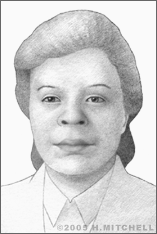Bessie Blount
Bessie Virginia Blount (1914-2009) led a remarkable life that began in Hickory, Virginia, where she was born on November 24, 1914. She made significant breakthroughs in assistive technologies and forensic science, becoming a role model for women and African Americans for her pioneering work.
Young Blount moved from Virginia to New Jersey to attend Panzar College of Physical Education and later, Union Junior College. It was her goal to become a physical therapist. She completed her studies in Chicago.
She became a practicing physical therapist, and, after World War II ended, many soldiers returned from the frontlines as amputees. As part of her physical therapy work, Blount taught veterans who did not have use of their hands and feet new ways to perform basic tasks. One major challenge for people in this condition is eating. It was important to many of them to be able to feed themselves in order to gain a feeling of independence and increase self-esteem.
Blount came up with a device that consisted of a tube that delivered individual bites of food to the patient at his or her own pace. All he or she needed to do was bite down on the tube for the next morsel to be delivered to the mouthpiece. An attached machine would deliver the next mouthful on cue. Later, while living in Newark, New Jersey, practicing physical therapy and teaching at Bronx Hospital in New York, she also created a simpler device that employed a neck brace with built-in support for a food receptacle such as a bowl, cup, or dish. For this, she received a patent under her married name, Bessie Griffin, in 1951.

Blount reportedly attempted to interest the American Veteran’s Association in these inventions, but she found it difficult to get much support, despite the devices’ potential benefit to thousands of people’s lives. She even appeared on a television show called “The Big Idea,” where she demonstrated her ideas in 1953. (She was the first woman and the first African American to appear on the program). Instead, she found support in the French government, to whom she eventually donated rights to both her inventions. She was quoted as saying that she had proven "that a black woman can invent something for the benefit of humankind."
Meanwhile, Blount cultivated a reputation among the inventor community. Among her closest friends was Theodore M. Edison, son of Thomas Alva Edison, with whom she discussed many ideas and projects. She continued to innovate, creating, among other things, a disposable cardboard emesis basin. She fashioned the basin by molding and baking a mixture made of flour, water, and newspaper. Once again, the American Veteran’s Administration Hospital was disinterested. She sold the idea to Belgium, who still uses a variation of her design in its hospitals nationwide.
A second career was in store for Blount in 1969, when she began working in law enforcement, conducting forensic science research for police departments in New Jersey and Virginia. She moved up quickly and, in 1977 was sent to train and work at Scotland Yard in England. Again, she was the first African American woman to be honored with such an opportunity. Next, she is said to have applied for a job with the FBI but was turned down. She then began operating her own business, using her forensic training to examine pre-civil war documents and so-called “slave” papers. She operated the business until the age of 83. And at the age of 95, Blount passed away on December 30, 2009 in Newfield, New Jersey.


